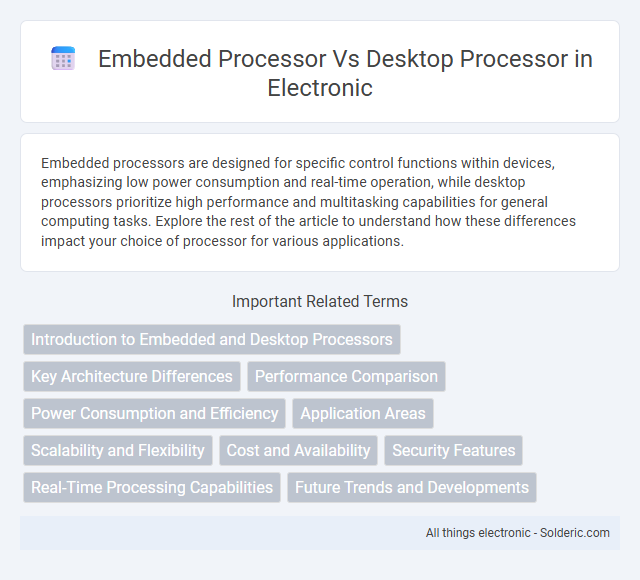Embedded processors are designed for specific control functions within devices, emphasizing low power consumption and real-time operation, while desktop processors prioritize high performance and multitasking capabilities for general computing tasks. Explore the rest of the article to understand how these differences impact your choice of processor for various applications.
Comparison Table
| Feature | Embedded Processor | Desktop Processor |
|---|---|---|
| Purpose | Dedicated, specific control tasks | General computing and multitasking |
| Power Consumption | Low power, energy-efficient | Higher power use, performance-oriented |
| Performance | Optimized for real-time, predictable tasks | High performance, supports complex applications |
| Architecture | Specialized, often RISC-based | Complex, often x86 or ARM desktop class |
| Integration | Includes peripherals on-chip for compact design | Requires separate components and peripherals |
| Cost | Low to moderate, optimized for mass production | Higher, aimed at consumer and professional use |
| Heat Generation | Minimal heat, often passively cooled | Significant heat, needs active cooling |
| Use Cases | IoT, automotive, industrial control, appliances | Personal computers, gaming, professional workstations |
Introduction to Embedded and Desktop Processors
Embedded processors are specialized microcontrollers designed to perform dedicated functions within systems like automotive controls, industrial machines, and consumer electronics, emphasizing low power consumption and real-time processing. Desktop processors, such as Intel Core and AMD Ryzen series, are general-purpose CPUs optimized for high performance, multitasking, and complex computing tasks in personal computers. The architectural differences reflect their use cases: embedded processors prioritize efficiency and reliability in constrained environments, while desktop processors deliver advanced computational power and flexibility for diverse applications.
Key Architecture Differences
Embedded processors typically emphasize energy efficiency and real-time performance with integrated peripherals and simplified instruction sets, whereas desktop processors prioritize high clock speeds, multi-core architectures, and advanced caches for maximum computational power. Embedded CPUs often feature specialized ARM or RISC designs optimized for low power consumption and small form factors, in contrast to desktop processors commonly based on x86 architectures with complex out-of-order execution and extensive SIMD capabilities. Memory hierarchy and thermal design also differ significantly, with embedded systems utilizing limited on-chip memory to reduce latency and desktop processors employing larger caches and sophisticated cooling solutions to sustain peak performance.
Performance Comparison
Embedded processors prioritize energy efficiency and thermal management, making them ideal for low-power, real-time applications but generally offer lower clock speeds and fewer cores compared to desktop processors. Desktop processors deliver significantly higher performance through advanced architectures, higher clock rates, and greater core counts, enabling superior multi-threading and computing capabilities for demanding tasks. Performance benchmarks reveal desktop processors excel in compute-intensive workloads, while embedded processors optimize for consistent, real-time performance within constrained power and thermal envelopes.
Power Consumption and Efficiency
Embedded processors are designed for low power consumption and high efficiency, making them ideal for battery-operated and energy-sensitive applications. Desktop processors consume significantly more power to deliver higher performance, which results in greater heat generation and the need for advanced cooling systems. Your choice between the two depends on whether energy efficiency or raw processing power is the priority for your specific application.
Application Areas
Embedded processors excel in specialized applications such as automotive systems, industrial automation, and IoT devices, where low power consumption and real-time performance are critical. Desktop processors are designed for general-purpose computing, supporting complex tasks like gaming, video editing, and software development with high processing power and multitasking capabilities. Your choice depends on whether the application requires focused efficiency or versatile performance across diverse software environments.
Scalability and Flexibility
Embedded processors offer superior scalability and flexibility due to their ability to be customized for specific applications, optimizing power consumption and performance in compact environments. Desktop processors provide greater raw computing power and support for multi-threaded tasks but lack the specialized adaptability found in embedded systems. Your choice should consider whether tailored efficiency or general-purpose performance best suits your project requirements.
Cost and Availability
Embedded processors typically have lower costs due to their specialized design for specific applications and mass production in high volumes, making them more budget-friendly for IoT devices and industrial use. Desktop processors, designed for general-purpose computing with higher performance capabilities, tend to be more expensive and are widely available through consumer electronics channels. Your choice depends on balancing cost constraints and availability requirements for your specific project needs.
Security Features
Embedded processors often include enhanced security features such as secure boot, hardware encryption, and tamper detection to protect sensitive data in IoT devices and industrial applications. Desktop processors typically offer robust security through integrated technologies like Intel's SGX or AMD's SEV, but they prioritize performance alongside security for general-purpose computing. Your choice depends on whether the application requires specialized hardware-based security for embedded environments or flexible, high-performance security solutions for desktop use.
Real-Time Processing Capabilities
Embedded processors excel in real-time processing capabilities due to their deterministic behavior and dedicated interrupt handling, making them ideal for time-sensitive applications in automotive and industrial control systems. Desktop processors, optimized for high throughput and complex multitasking, often lack the guaranteed response times required for real-time operations. The architecture of embedded processors prioritizes low latency and predictable execution, critical for embedded systems where timing is paramount.
Future Trends and Developments
Future trends in embedded processors emphasize energy efficiency, integration of AI capabilities, and enhanced real-time processing to support IoT and edge computing applications. Desktop processors continue to evolve with advancements in multi-core architectures, higher clock speeds, and improved support for virtualization and high-performance computing tasks. Emerging technologies such as heterogeneous computing and advanced semiconductor processes drive innovation in both processor types, tailoring performance and power consumption to their specific use cases.
Embedded processor vs desktop processor Infographic

 solderic.com
solderic.com